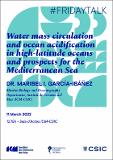Por favor, use este identificador para citar o enlazar a este item:
http://hdl.handle.net/10261/266656COMPARTIR / EXPORTAR:
 SHARE
BASE SHARE
BASE
|
|
| Visualizar otros formatos: MARC | Dublin Core | RDF | ORE | MODS | METS | DIDL | DATACITE | |

| Campo DC | Valor | Lengua/Idioma |
|---|---|---|
| dc.contributor.author | García-Ibáñez, Maribel I. | es_ES |
| dc.date.accessioned | 2022-04-08T08:54:14Z | - |
| dc.date.available | 2022-04-08T08:54:14Z | - |
| dc.date.issued | 2022-03-11 | - |
| dc.identifier.citation | Xerrades del divendres - Friday´s talks (2022) | es_ES |
| dc.identifier.uri | http://hdl.handle.net/10261/266656 | - |
| dc.description.abstract | The global ocean has mediated the atmospheric CO2 increase derived from human activities by absorbing about 30% of the anthropogenic emissions since the industrial revolution. CO2 enters the surface ocean through air-sea gas exchange and its uptake rate is limited by the upper-ocean-to-interior transport, i.e., the large-scale dynamics that control the ventilation of the interior ocean. Hence, the high-latitude oceans, where deep convective overturning and subduction occur, are the areas of strongest CO2 uptake and deep-ocean CO2 sequestration. Amongst those high-latitude oceans, the North Atlantic is one of the most important CO2 sinks thanks to the Atlantic meridional overturning circulation, where the deep-water formation provides the pathway for CO2 into the interior ocean. Here a database analysis is used to study the long-term trends in ocean acidification in the different water masses. I will also discuss the physical and chemical drivers of the ocean acidification and the expected changes for future increases in atmospheric CO2. Finally, I will present my Severo Ochoa postdoctoral project, which focuses on assessing the changes in alkalinity naturally occurring in the Mediterranean Sea and how they affect the ocean acidification signal in the Mediterranean Sea and the North Atlantic | es_ES |
| dc.language.iso | eng | es_ES |
| dc.publisher | CSIC - Instituto de Ciencias del Mar (ICM) | es_ES |
| dc.rights | openAccess | es_ES |
| dc.title | Water mass circulation and ocean acidification in high-latitude oceans and prospects for the Mediterranean Sea | es_ES |
| dc.type | material didáctico | es_ES |
| dc.description.peerreviewed | Peer reviewed | es_ES |
| dc.relation.publisherversion | https://youtu.be/TsrR86SR0Aw | es_ES |
| dc.relation.csic | Sí | es_ES |
| oprm.item.hasRevision | no ko 0 false | * |
| item.openairetype | material didáctico | - |
| item.grantfulltext | open | - |
| item.cerifentitytype | Publications | - |
| item.openairecristype | http://purl.org/coar/resource_type/c_18cf | - |
| item.fulltext | With Fulltext | - |
| item.languageiso639-1 | en | - |
| Aparece en las colecciones: | (ICM) Seminarios científicos | |
Ficheros en este ítem:
| Fichero | Descripción | Tamaño | Formato | |
|---|---|---|---|---|
| Garcia_Ibañez_2022.mp4 | 331,58 MB | MP4 | Visualizar/Abrir | |
| Garcia_Ibañez_2022.pdf | 84,39 kB | Adobe PDF |  Visualizar/Abrir |
CORE Recommender
NOTA: Los ítems de Digital.CSIC están protegidos por copyright, con todos los derechos reservados, a menos que se indique lo contrario.
